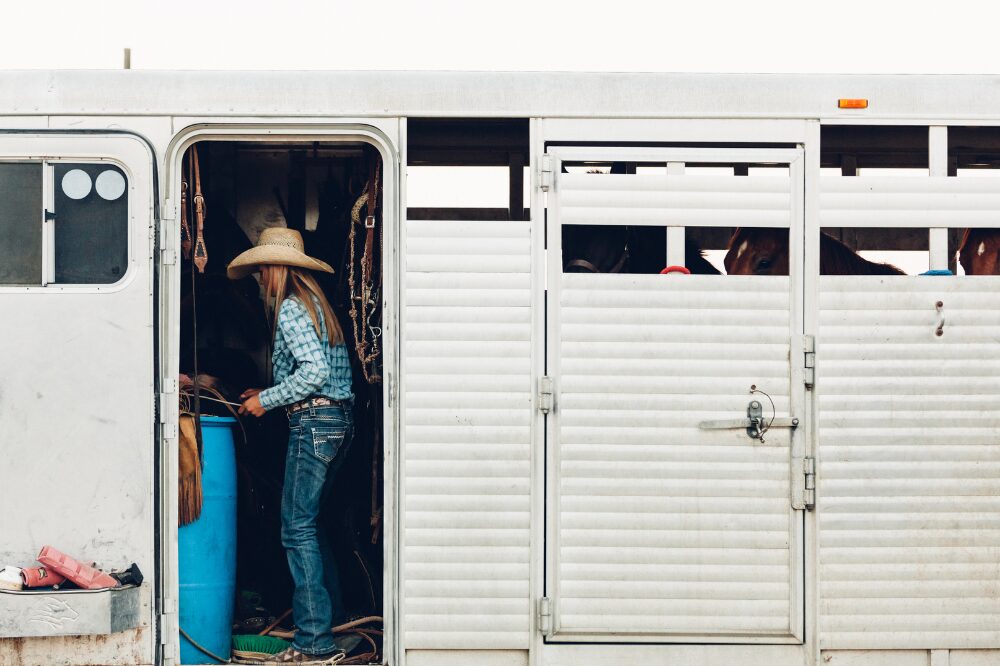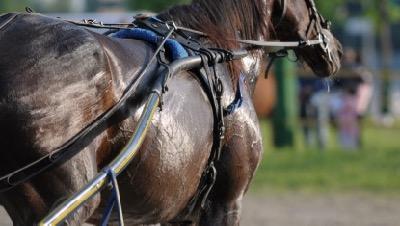Top Tips for Trailering Horses in Hot Weather
Are you getting ready to haul your horse this summer? Warm weather and longer days make spending time with your horse more fun, and there are more opportunities for horse shows, clinics, and trail riding adventures. Follow these tips for trailering horses in hot weather for the safest ride possible. Talk to your vet about your horse’s health and stamina to ensure your journey is appropriate for their fitness. Your vet can advise you on medications, electrolytes, and other health care tips for a smooth horse trailer journey.
Table of Contents

Get Ready BEFORE Trailering Horses in Hot Weather
- You can do some of these things the day before a trip to save time the next day.
- Pre-cool the trailer – Keep your rig parked in the shade, with open roof vents and side windows. This includes the tack or dressing room.
- Check the tire pressure – Consult the trailer’s owner manual and the tire information about the ideal pressure to avoid blowouts.
- Check your fans – Battery-operated or hard-wired fans in the trailer boost airflow and help evaporative cooling as your horse sweats. It’s not air conditioning, but fans are the next best thing.
- Add shavings on the mats – Shavings add comfort and cushion and can make a huge difference for your horse’s safety, as they won’t slip on manure or urine. On the day of your trip, toss a few bags of ice into the shavings (ditch the bags and spread the ice around). Rumor has it that this can help your horse’s body stay cooler in high heat.
- Store tack separately in your truck or trailer’s storage area – This gives your equine buddy more room for wind to cool them off, even if it’s hot air.
- Use a thermometer – Monitor trailer horse compartment temperature inside with a thermometer designed for trailers, out of the reach of horses.
Prep Your Horse
- You’ll have much to do on the morning of a big trip. Do these things for added safety.
- Hydrate beforehand – Give electrolytes to your horse the day before and the morning of unless otherwise advised by your vet. Offer water before loading.
- Skip your horse’s grain ration or minimize it. Keep the diet simple on travel day.
- Use slow feeders while traveling. Wet the hay to reduce dust. A quick dunk is all you need.
- Keep the legs protected, but not in heavy wraps. Shipping boots offer the most protection and are loose compared to standing wraps.
- If it’s already hot, cool your horse before loading – Sponge down or mist your horse with cool water.
- Use fly masks – Dust from the road, hay, and shavings will blow around in the trailer. A mask with ears allows airflow and helps keep dust from their eyes, ears, and nose.
- Use earplugs to minimize stress from road noise if your horse is used to them.

Route Planning
- Travel early or late – Take advantage of the cooler temperatures.
- Avoid traffic – Plan around rush hour and other high-traffic areas. Plan alternate routes if you end up in surprise traffic.
- Know your route – Avoid situations that may stress your horse, like loud construction zones, switchbacks, and extra-hilly roads.
- Plan fuel stops with shade – Choose shaded areas or tree-lined lots when possible. Refreshment stops for you are equally important.
- For long trips, utilize rest stops and know where the easy-to-access gas stations are.
- On extra-long trips, know where you can find layovers and local veterinarians.
On the Road
- Keep it moving – Minimize unnecessary stops to keep air flowing, BUT stop every hour to check your horse and offer water.
- Safe window access – Let air in without risk of injury with screens. Open sides or slats are best when you install a screen.
- Shorter trips – Break up long hauls into a few shorter trips with comfortable layovers.
- Monitor closely – Check for signs of distress during stops – check gums and skin for signs of dehydration and monitor breathing. A dehydrated horse’s skin won’t snap back, and the gums will be dry.
- Have emergency water – Keep fresh water from home on the road, and make a few extra rations with your horse’s favorite flavored water to encourage your horse’s water intake.
- Check that your horse has been urinating and passing manure.
- Look for signs of heat distress like rapid breathing, too much sweat or not sweating, and dry or discolored gums.
When You Arrive
- Check your horse’s vital signs – pulse, respiration, temperature, gums, and digital pulses. Your horse’s temperature should be normal, and if elevated, talk to a veterinarian and then check every few minutes to track if it’s returning to normal.
- Abnormal vital signs could result from stress from trailing on hot summer days, or there is shipping fever brewing. Early intervention is key to a quick recovery.
- Let your horse settle in with fresh water and a slow feeder. You may want to skip concentrated feeds after a long ride, too. The water you offer doesn’t have to be cold. Many horses prefer cold water, but will drink more warm water. Continue to monitor your horse’s water intake.
- Check your horse’s legs and rinse them if necessary.
- And the last thing to notice is any signs of heat stress – Watch for rapid breathing, heavy sweating, or lethargy.

Ideally, horses wear breakaway halters in trailers and the windows are closed when going down the road.
How hot is too hot to trailer horses?
Work with your vet to understand your horse’s health and fitness for trailer rides in the heat. It will always be too hot if your horse overheats, colics, or gets shipping fever, and your vet will help you develop a plan for safe travel.
- The best way to prep for a trip in the heat is with your vet’s help. Fit, healthy horses will fare better, and do what you can to minimize your horse’s stress. Trailing horses in hot weather has some challenges, and there’s a lot you can do to make it easier. Then enjoy a beautiful summer day adventuring with your equine friend.
Go Shopping
Stock up here for your horse supplies! As an Amazon Associate, I earn from qualifying purchases, but it’s ZERO extra cents to you. As a Walmart Associate, I earn from qualifying purchases as part of their affiliate plan. I appreciate your support! You can also visit my Amazon storefront here: PEG storefront.
Don't fumble hooking up your rig, and keep tabs on how your horses are doing inside.
check on the temp of your rig easily with this tiny device!
A thermometer is one of the best investments in your horse's health you can use.
2 sizes of this slow-feeding hanging hay toy - snack size holds a few flakes, and the half size holds 1/2 bale. There's also an XL that ground feeds.
Use code 15PROEQUINE for sitewide savings on slow feeders and more.










